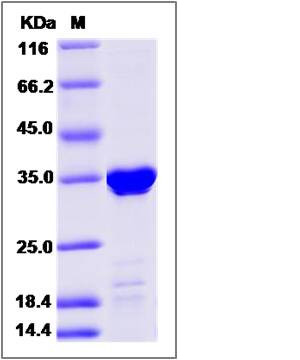Human TPM1 / Tropomyosin-1 Protein (His Tag)
C15orf13,CMD1Y,CMH3,HTM-alpha,LVNC9,TMSA
- 100ug (NPP2550) Please inquiry
| Catalog Number | P14615-H07E |
|---|---|
| Organism Species | Human |
| Host | E. coli |
| Synonyms | C15orf13,CMD1Y,CMH3,HTM-alpha,LVNC9,TMSA |
| Molecular Weight | The recombinant human TPM1 consists of 299 amino acids and predicts a molecular mass of 34.7 KDa. It migrates as an approximately 35 KDa band in SDS-PAGE under reducing conditions. |
| predicted N | His |
| SDS-PAGE |  |
| Purity | > 90 % as determined by SDS-PAGE |
| Protein Construction | A DNA sequence encoding the human TPM1 (NP_000357.3) (Met1-Met284) was expressed with a polyhistide tag at the N-terminus. |
| Bio-activity | |
| Research Area | Immunology |Signal Transduction |Cytoskeleton / ECM |Cytoskeletal Proteins |Microfilaments |Actin etc | |
| Formulation | Lyophilized from sterile PBS, 10% Glycerol, pH 7.4. 1. Normally 5 % - 8 % trehalose and mannitol are added as protectants before lyophilization. Specific concentrations are included in the hardcopy of COA. |
| Background | TPM1, also known as tropomyosin-1, is a member of the tropomyosin family. Members of this family are highly conserved, widely distributed actin-binding proteins involved in the contractile system of striated and smooth muscles and the cytoskeleton of non-muscle cells. highly conserved, widely distributed actin-binding proteins involved in the contractile system of striated and smooth muscles and the cytoskeleton of non-muscle cells. TPM1 is one type of alpha helical chain that forms the predominant tropomyosin of striated muscle. It binds to actin filaments in muscle and non-muscle cells. TPM1 plays a central role, in association with the troponin complex, in the calcium dependent regulation of vertebrate striated muscle contraction. |
| Reference |
